Transfer Hydrogenation of Vanillin with Formic Acid over Graphene-Encapsulated Nitrogen-Doped Bimetallic Magnetic Pd/Fe@N/C Catalyst
Abstract
1. Introduction
2. Results and Discussion
2.1. Synthesis and Characterization of the Catalysts
2.2. Pd/Fe@N/C Catalyzed Selective Hydrogenation of Vanillin
2.3. Proposed Mechanism of Pd/Fe@N/C Catalyzed Hydrogenation of Vanillin
3. Experimental Section
3.1. Materials and Catalyst Preparation
3.2. Catalysts Characterization
3.3. Catalytic Tests
4. Conclusions
Author Contributions
Funding
Data Availability Statement
Conflicts of Interest
References
- Khandaker, T.; Islam, T.; Nandi, A.; Anik, M.A.A.M.; Hossain, M.S.; Hasan, M.K.; Hossain, M.S. Biomass-derived carbon materials for sustainable energy applications: A comprehensive review. Sustain. Energy Fuels 2025, 9, 693–723. [Google Scholar] [CrossRef]
- Su, C.; Zou, S.; Li, J.; Wang, L.; Huang, J. Supporting Nano Catalysts for the Selective Hydrogenation of Biomass-derived Compounds. ChemSusChem 2024, 17, e202400602. [Google Scholar] [CrossRef] [PubMed]
- Dutta, S. Catalytic Transformation of Biomass into Sustainable Carbocycles: Recent Advances, Prospects, and Challenges. ChemPlusChem 2025, 90, e202400568. [Google Scholar] [CrossRef]
- Bhardwaj, A.; Kaur, J.; Wuest, M.; Wuest, F. In situ click chemistry generation of cyclooxygenase-2 inhibitors. Nat. Commun. 2017, 8, 1. [Google Scholar] [CrossRef]
- Bellardita, M.; Yurdakal, S.; Tek, B.S.; Degirmenci, C.; Palmisano, G.; Loddo, V.; Palmisano, L.; Soria, J.; Sanz, J.; Augugliaro, V.J. Tuning the selectivity to aldehyde via pH regulation in the photocatalytic oxidation of 4-methoxybenzyl alcohol and vanillyl alcohol by TiO2 catalysts. Environ. Chem. Eng. 2021, 9, 105308. [Google Scholar] [CrossRef]
- Guo, X.; Gao, G.; Remon, J.; Ma, Y.; Jiang, Z.; Shi, B.; Tsang, D.C.W. Selective hydrogenation of vanillin to vanillyl alcohol over Pd, Pt, and Au catalysts supported on an advanced nitrogen-containing carbon material produced from food waste. Chem. Eng. J. 2022, 440, 135885. [Google Scholar] [CrossRef]
- Duan, M.; Cheng, Q.; Wang, M.; Wang, Y. In situ hydrodeoxygenation of vanillin over Ni–Co–P/HAP with formic acid as a hydrogen source. RSC Adv. 2021, 11, 10996–11003. [Google Scholar] [CrossRef] [PubMed]
- Alijani, S.; Capelli, S.; Evangelisti, C.; Prati, L.; Villa, A.; Cattaneo, S. Influence of carbon support properties in the hydrodeoxygenation of vanillin as lignin model compound. Catal. Today 2021, 367, 220–227. [Google Scholar] [CrossRef]
- Gao, J.; Cao, Y.; Luo, G.; Fan, J.; Clark, J.H.; Zhang, S. High-efficiency catalytic hydrodeoxygenation of lignin-derived vanillin with nickel-supported metal phosphate catalysts. Chem. Eng. J. 2022, 448, 137723. [Google Scholar] [CrossRef]
- Fan, R.; Chen, C.; Han, M.; Gong, W.; Zhang, H.; Zhang, Y.; Zhao, H.; Wang, G. Highly Dispersed Copper Nanoparticles Supported on Activated Carbon as an Efficient Catalyst for Selective Reduction of Vanillin. Small 2018, 14, 1801953. [Google Scholar] [CrossRef]
- Ma, Y.; Xu, G.; Wang, H.; Wang, Y.; Zhang, Y.; Fu, Y. Cobalt Nanocluster Supported on ZrREnOx for the Selective Hydrogenation of Biomass Derived Aromatic Aldehydes and Ketones in Water. ACS Catal. 2018, 8, 1268–1277. [Google Scholar] [CrossRef]
- Zhao, Z.; Huang, S.; Dong, G.; Chen, Y.; Wang, M.; Xia, M.; Song, X.; Li, X.; Wei, Z.; Wang, J. Engineering the electronic structure of Pt for selective hydrogenation of vanillin to vanillyl alcohol and p-cresol. Chem. Eng. Sci. 2024, 300, 120616. [Google Scholar] [CrossRef]
- Hao, C.; Guo, X.; Pan, Y.; Chen, S.; Jiao, Z.; Yang, H.; Guo, X. Visible-Light-Driven Selective Photocatalytic Hydrogenation of Cinnamaldehyde over Au/SiC Catalysts. J. Am. Chem. Soc. 2016, 138, 9361–9364. [Google Scholar] [CrossRef]
- Zhu, J.; Ding, X.; Li, D.; Dou, M.; Lu, M.; Li, Y.; Luo, F. Graphene Oxide-Supported Catalyst with Thermoresponsive Smart Surface for Selective Hydrogenation of Cinnamaldehyde. ACS Appl. Mater. Interfaces 2019, 11, 16443–16451. [Google Scholar] [CrossRef] [PubMed]
- Jia, A.; Zhang, Y.; Song, T.; Hu, Y.; Zheng, W.; Luo, M.; Lu, J.; Huang, W. The effects of TiO2 crystal-plane-dependent Ir-TiOx interactions on the selective hydrogenation of crotonaldehyde over Ir/TiO2 catalysts. Chin. J. Catal. 2021, 42, 1742–1754. [Google Scholar] [CrossRef]
- Guo, Q.; Wang, Y.; Han, J.; Zhang, J.; Wang, F. Interfacial Tandem Catalysis for Ethylene Carbonylation and C–C Coupling to 3-Pentanone on Rh/Ceria. ACS Catal. 2022, 12, 3286–3290. [Google Scholar] [CrossRef]
- Chen, S.; Meng, L.; Chen, B.; Chen, W.; Duan, X.; Huang, X.; Zhang, B.; Fu, H.; Wan, Y. Poison Tolerance to the Selective Hydrogenation of Cinnamaldehyde in Water over an Ordered Mesoporous Carbonaceous Composite Supported Pd Catalyst. ACS Catal. 2017, 7, 2074–2087. [Google Scholar] [CrossRef]
- Guo, M.; Jayakumar, S.; Luo, M.; Kong, X.; Li, C.; Li, H.; Chen, J.; Yang, Q. The promotion effect of π-π interactions in Pd NPs catalysed selective hydrogenation. Nat. Commun. 2022, 13, 1770. [Google Scholar] [CrossRef]
- Meyer, L.C.; Sanyal, U.; Stoerzinger, K.A.; Koh, K.; Fulton, J.L.; Camaioni, D.M.; Gutierrez, O.Y.; Lercher, J.A. Influence of the Molecular Structure on the Electrocatalytic Hydrogenation of Carbonyl Groups and H2 Evolution on Pd. ACS Catal. 2022, 12, 11910–11917. [Google Scholar] [CrossRef]
- Yangcheng, R.; Ran, J.; Liu, Z.; Cui, Y.; Wang, J. Phosphoric acid-modified commercial kieselguhr supported palladium nanoparticles as efficient catalysts for low-temperature hydrodeoxygenation of lignin derivatives in water. Green Chem. 2022, 24, 1570–1577. [Google Scholar] [CrossRef]
- Yoshii, T.; Umemoto, D.; Kuwahara, Y.; Mori, K.; Yamashita, H. Engineering of Surface Environment of Pd Nanoparticle Catalysts on Carbon Support with Pyrene–Thiol Ligands for Semihydrogenation of Alkynes. ACS Appl. Mater. Interfaces 2019, 11, 37708–37719. [Google Scholar] [CrossRef]
- Liu, J.; Wang, N.; Liu, J.; Li, M.; Xu, Y.; Wang, C.; Wang, Y.; Zheng, H.; Ma, L. The Immobilization of Pd(II) on Porous Organic Polymers for Semihydrogenation of Terminal Alkynes. ACS Appl. Mater. Interfaces 2020, 12, 51428–51436. [Google Scholar] [CrossRef]
- Goncalves, L.P.L.; Wang, J.; Vinati, S.; Barborini, E.; Wei, X.; Heggen, M.; Franco, M.; Sousa, J.P.S.; Petrovykh, D.Y.; Soares, O.; et al. Combined experimental and theoretical study of acetylene semi-hydrogenation over Pd/Al2O3. Int. J. Hydrog. Energy 2020, 45, 1283–1296. [Google Scholar] [CrossRef]
- Li, Z.; Hu, M.; Liu, B.; Liu, J.; Wang, P.; Yao, J.; Zhang, X.; He, M.; Song, W. Pd−Zn Alloy Nanoparticles Encapsulated into Mesoporous Silica with Confinement Effect for Highly Selective Semi-Hydrogenation of Phenylacetylene. ChemCatChem 2021, 13, 868–873. [Google Scholar] [CrossRef]
- Bhuyan, D.; Selvaraj, K.; Saikia, L. Pd@SBA-15 nanocomposite catalyst: Synthesis and efficient solvent-free semihydrogenation of phenylacetylene under mild conditions. Microporous Mesoporous Mat. 2017, 241, 266–273. [Google Scholar] [CrossRef]
- Liu, L.; Qiu, C.; Zhong, D.; Si, J.; Zhang, Z.; Peng, L. Scaling down contact length in complementary carbon nanotube field-effect transistors. Nanoscale 2017, 9, 9615–9621. [Google Scholar] [CrossRef] [PubMed]
- Zhu, Y.; Wang, W.; Sun, X.; Fan, M.; Dong, Z. Palladium Nanoclusters Confined in MOF@COP as a Novel Nanoreactor for Catalytic Hydrogenation. ACS Appl. Mater. Interfaces 2020, 12, 7285–7294. [Google Scholar] [CrossRef]
- Huang, F.; Deng, Y.; Chen, Y.; Cai, X.; Peng, M.; Jia, Z.; Ren, P.; Xiao, D.; Wen, X.; Wang, N.; et al. Atomically Dispersed Pd on Nanodiamond/Graphene Hybrid for Selective Hydrogenation of Acetylene. J. Am. Chem. Soc. 2018, 140, 13142–13146. [Google Scholar] [CrossRef] [PubMed]
- Nie, R.; Miao, M.; Du, W.; Shi, J.; Liu, Y.; Hou, Z. Selective hydrogenation of C=C bond over N-doped reduced graphene oxides supported Pd catalyst. Appl. Catal. B-Environ. 2016, 180, 607–613. [Google Scholar] [CrossRef]
- Yan, H.; Cheng, H.; Yi, H.; Lin, Y.; Yao, T.; Wang, C.; Li, J.; Wei, S.; Lu, J. Single-Atom Pd1/Graphene Catalyst Achieved by Atomic Layer Deposition: Remarkable Performance in Selective Hydrogenation of 1,3-Butadiene. J. Am. Chem. Soc. 2015, 137, 10484–10487. [Google Scholar] [CrossRef]
- Chen, X.; Wu, G.; Chen, J.; Chen, X.; Xie, Z.; Wang, X. Synthesis of “Clean” and Well-Dispersive Pd Nanoparticles with Excellent Electrocatalytic Property on Graphene Oxide. J. Am. Chem. Soc. 2011, 133, 3693–3695. [Google Scholar] [CrossRef]
- Siamaki, A.R.; Khder, A.E.S.; Abdelsayed, V.; El-Shall, M.S.; Gupton, B.F. Microwave-assisted synthesis of palladium nanoparticles supported on graphene: A highly active and recyclable catalyst for carbon–carbon cross-coupling reactions. J. Catal. 2011, 279, 1–11. [Google Scholar] [CrossRef]
- Chatterjee, M.; Ishizaka, T.; Kawanami, H.J. Preparation and characterization of PdO nanoparticles on trivalent metal (B, Al and Ga) substituted MCM-41: Excellent catalytic activity in supercritical carbon dioxide. Colloid Interface Sci. 2014, 420, 15–26. [Google Scholar] [CrossRef]
- Zharig, T.; Asefa, T. Heteroatom-Doped Carbon Materials for Hydrazine Oxidation. Adv. Mater. 2019, 31, 1804394. [Google Scholar] [CrossRef]
- Guo, H.; Wang, G.; Zhang, B.; Li, J.; Sui, W.; Jia, H.; Si, C. Ultrafine Ru nanoparticles deposited on lignin-derived nitrogen-doped carbon nanolayer for the efficient conversion of levulinic acid to γ-valerolactone. Renew. Energy 2024, 222, 119954. [Google Scholar] [CrossRef]
- Hu, D.; Xu, H.; Zeng, Y.; Lin, L.; Jiang, Z.; Yan, K. Selective hydrogenation of benzoic acid over bimetallic NiCo embedded in N-doped carbon. AIChE J. 2024, 70, e18276. [Google Scholar] [CrossRef]
- Qian, H.; Huang, H.; Wang, X. Design and synthesis of palladium/graphitic carbon nitride/carbon black hybrids as high-performance catalysts for formic acid and methanol electrooxidation. J. Power Sources 2015, 275, 734–741. [Google Scholar] [CrossRef]
- Estrade-Szwarckopf, H. XPS photoemission in carbonaceous materials: A “defect” peak beside the graphitic asymmetric peak. Carbon 2004, 42, 1713–1721. [Google Scholar] [CrossRef]
- Wu, P.; Qian, Y.; Du, P.; Zhang, H.; Cai, C. Facile synthesis of nitrogen-doped graphene for measuring the releasing process of hydrogen peroxide from living cells. J. Mater. Chem. 2012, 22, 6402–6412. [Google Scholar] [CrossRef]
- Liang, Y.; He, J.; An, Y.; Zhang, J.; Park, G.S.; Zhao, L.; Oh, R.; Huang, X.; Dong, J.; Liu, L. Boosting selective hydrogenation of α,β-unsaturated aldehydes through constructing independent Pt and Fe active sites on support. Chem. Eng. J. 2024, 484, 149670. [Google Scholar] [CrossRef]
- Gholinejad, M.; Bashirimousavi, S.; Sansano, J.M. Novel magnetic bimetallic AuCu catalyst for reduction of nitroarenes and degradation of organic dyes. Sci. Rep. 2024, 14, 5852. [Google Scholar] [CrossRef] [PubMed]
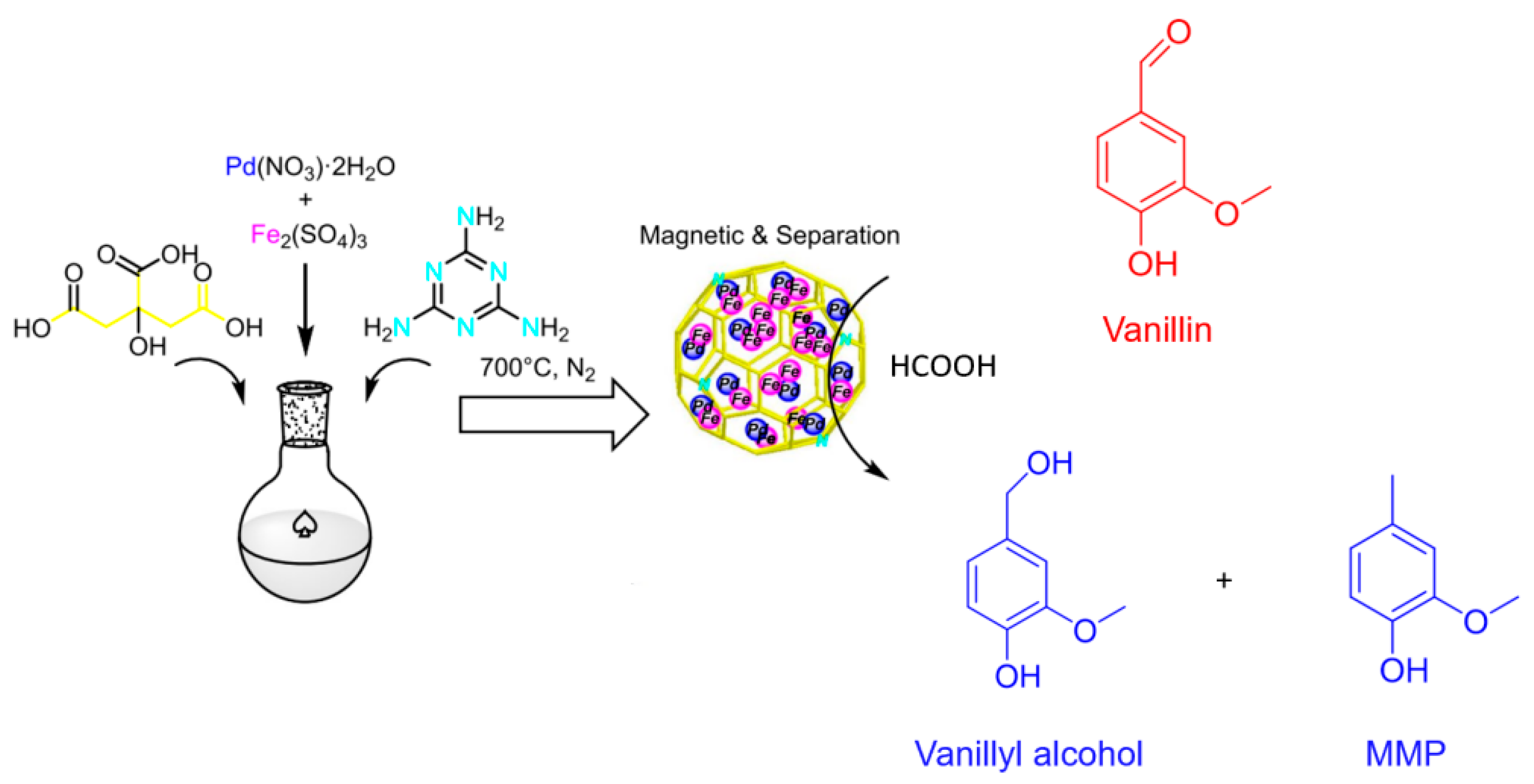
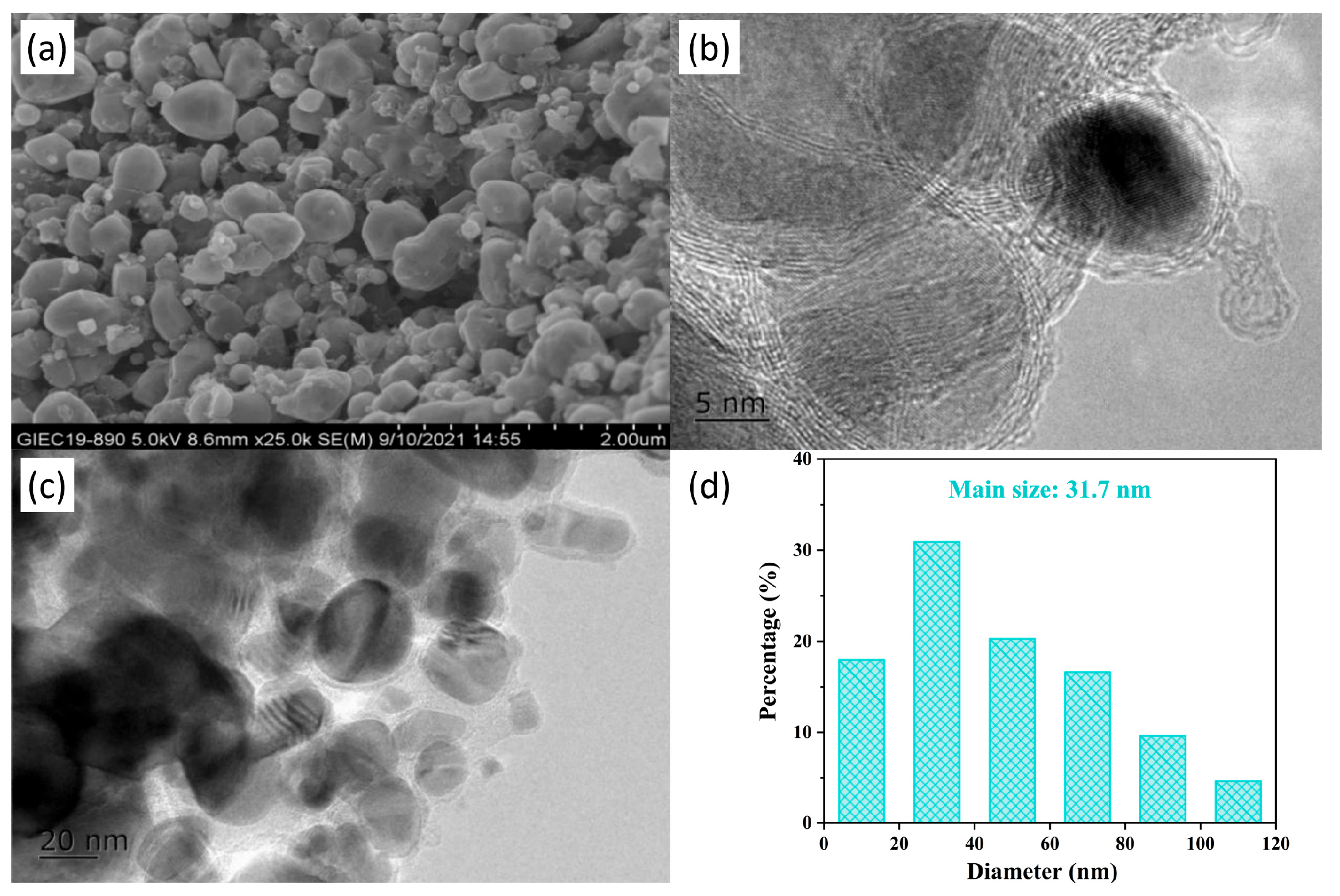
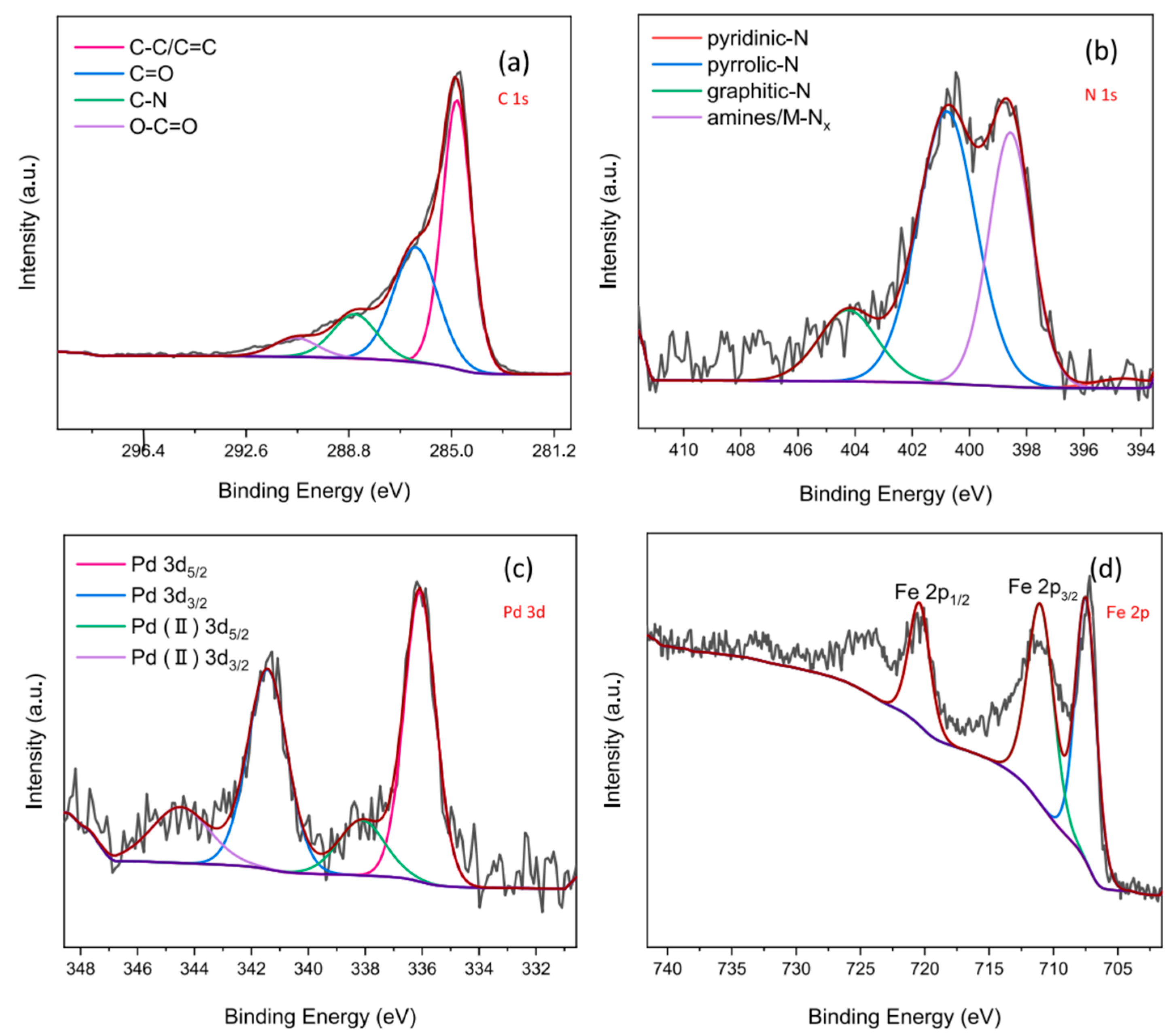
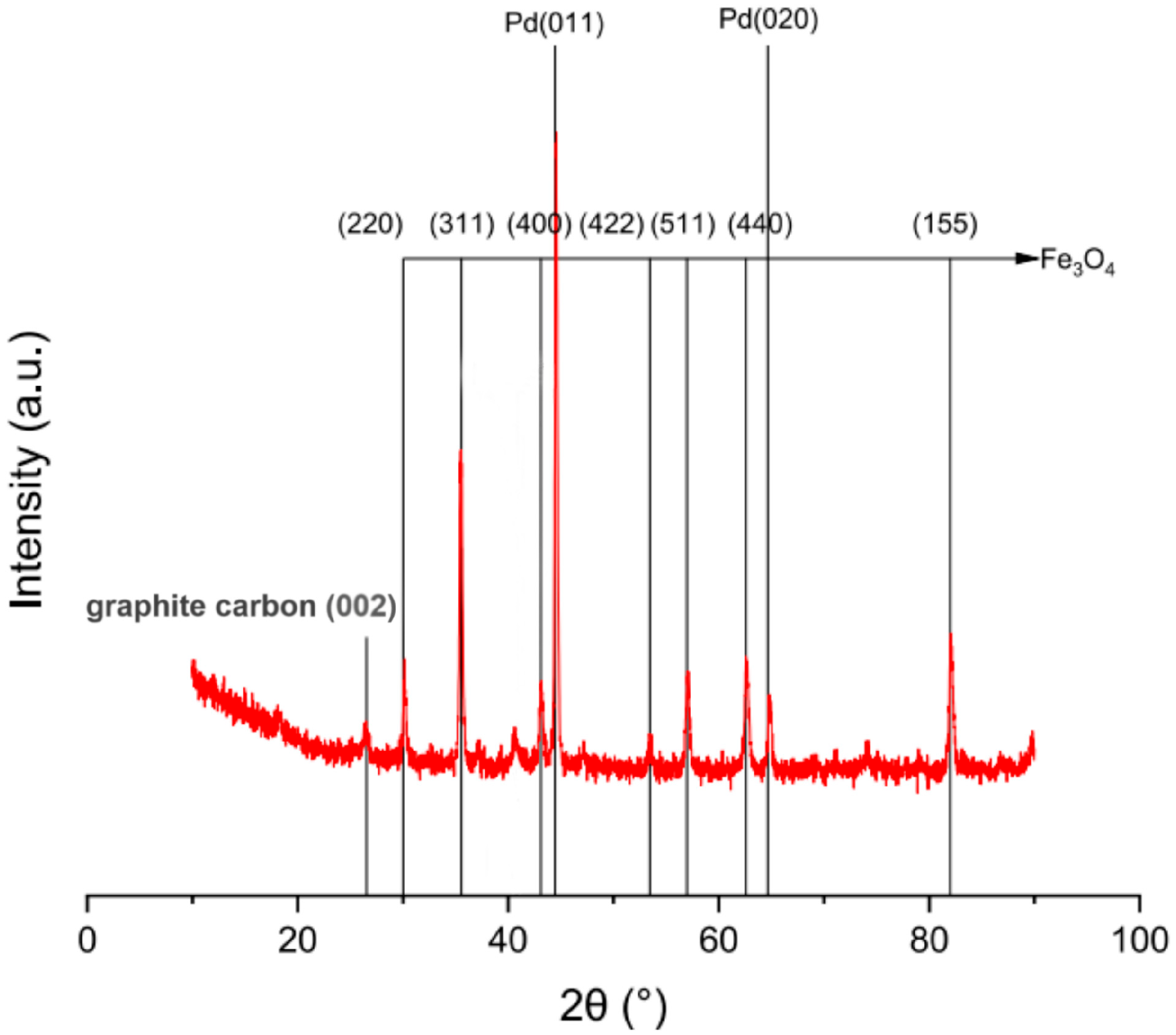
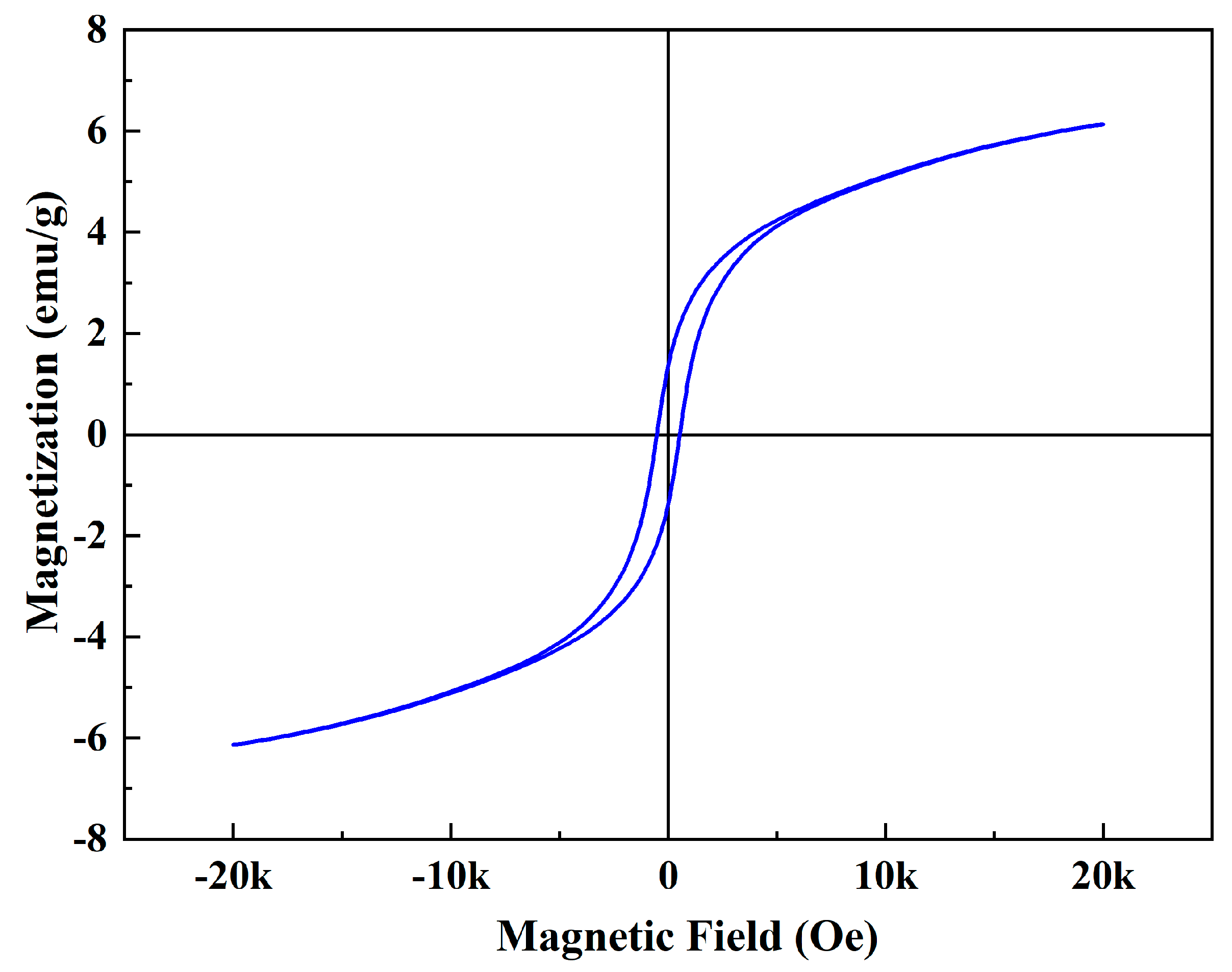
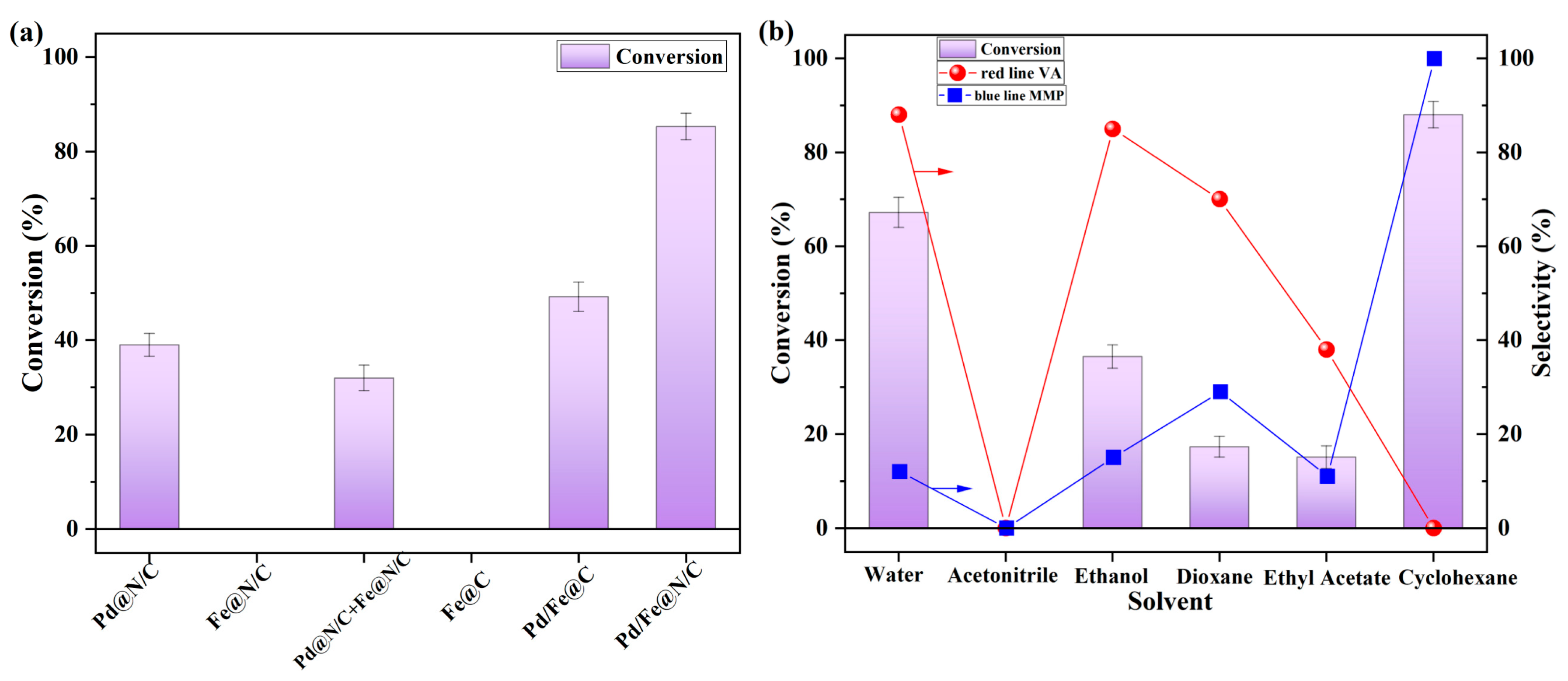
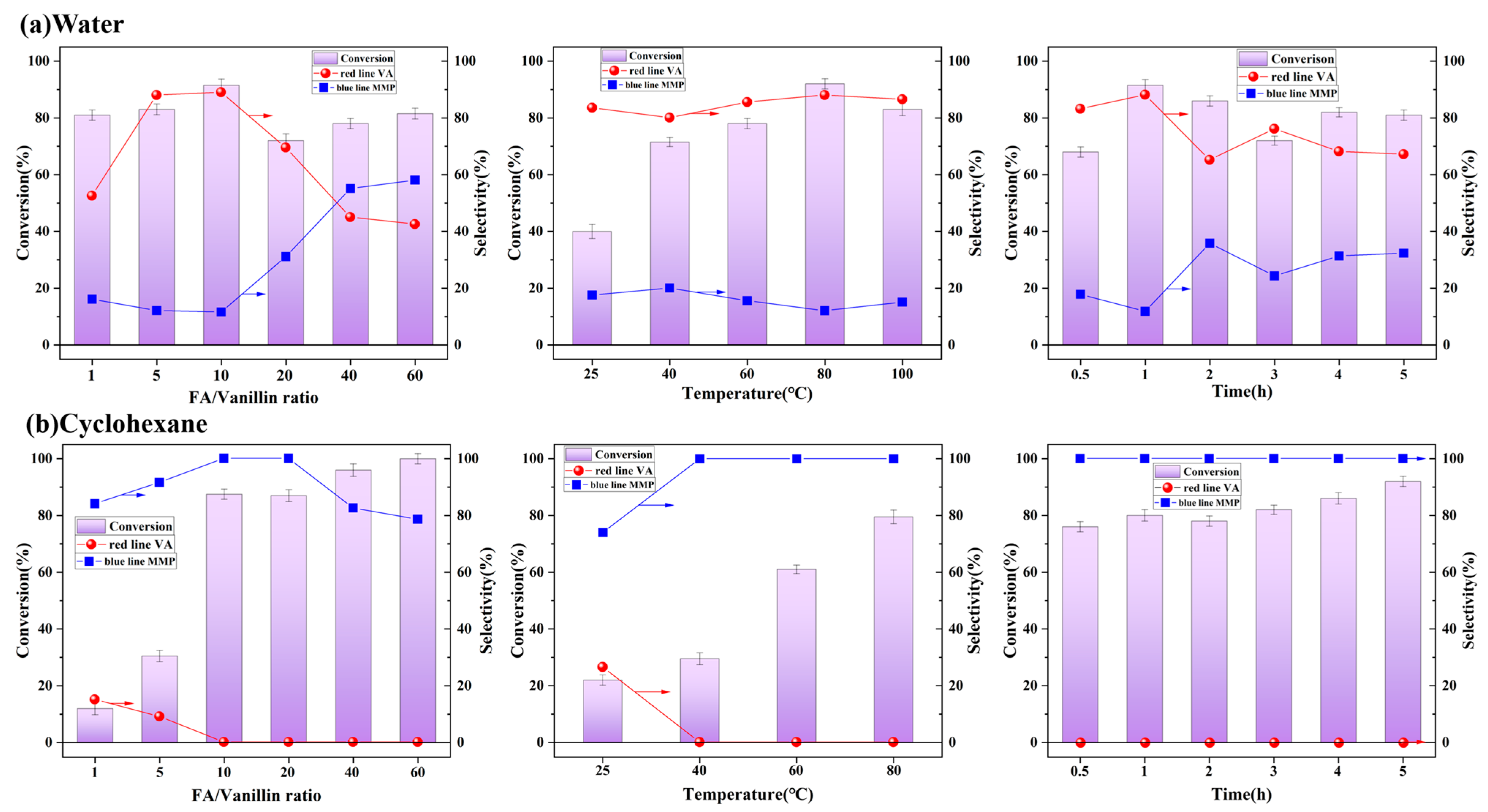
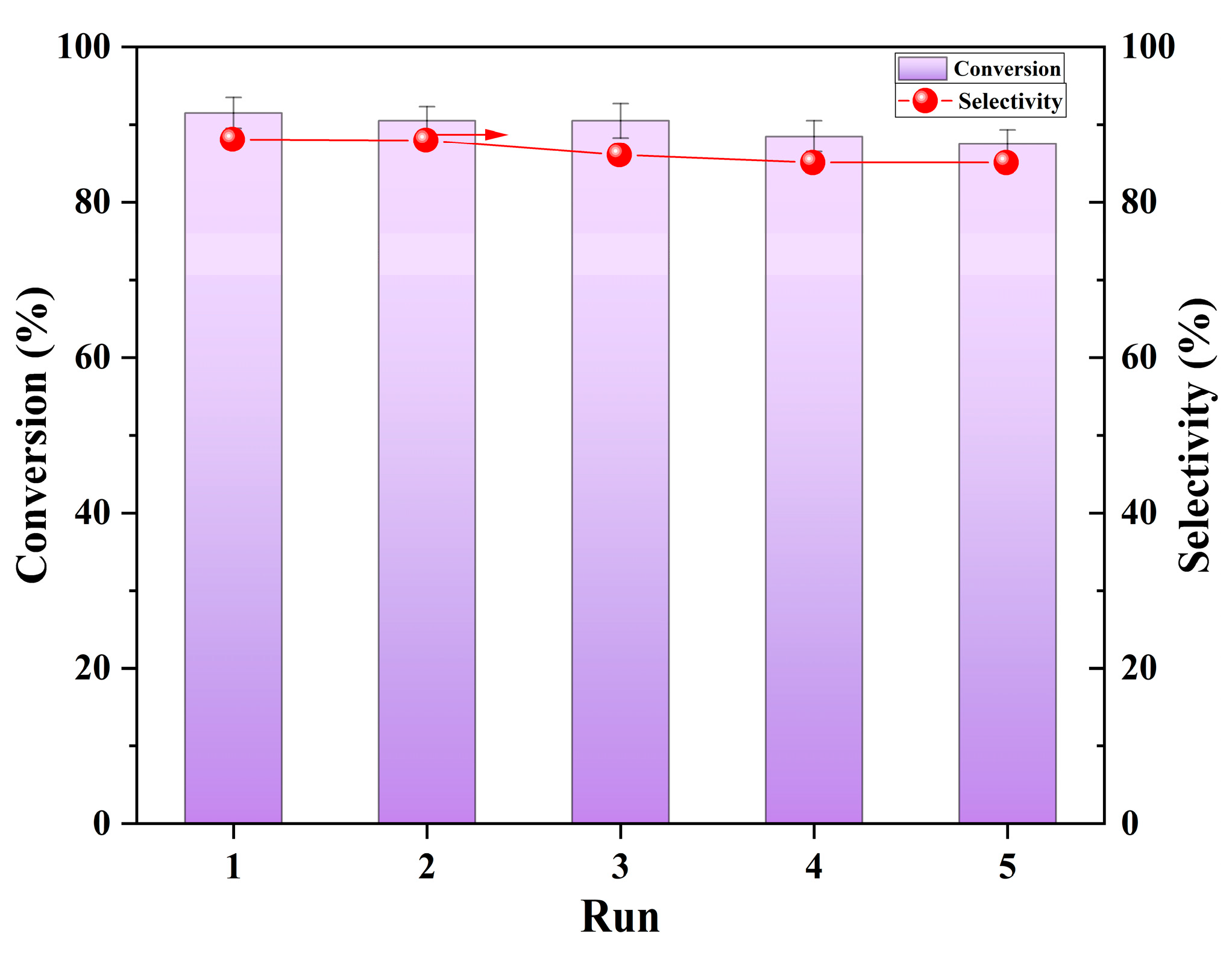
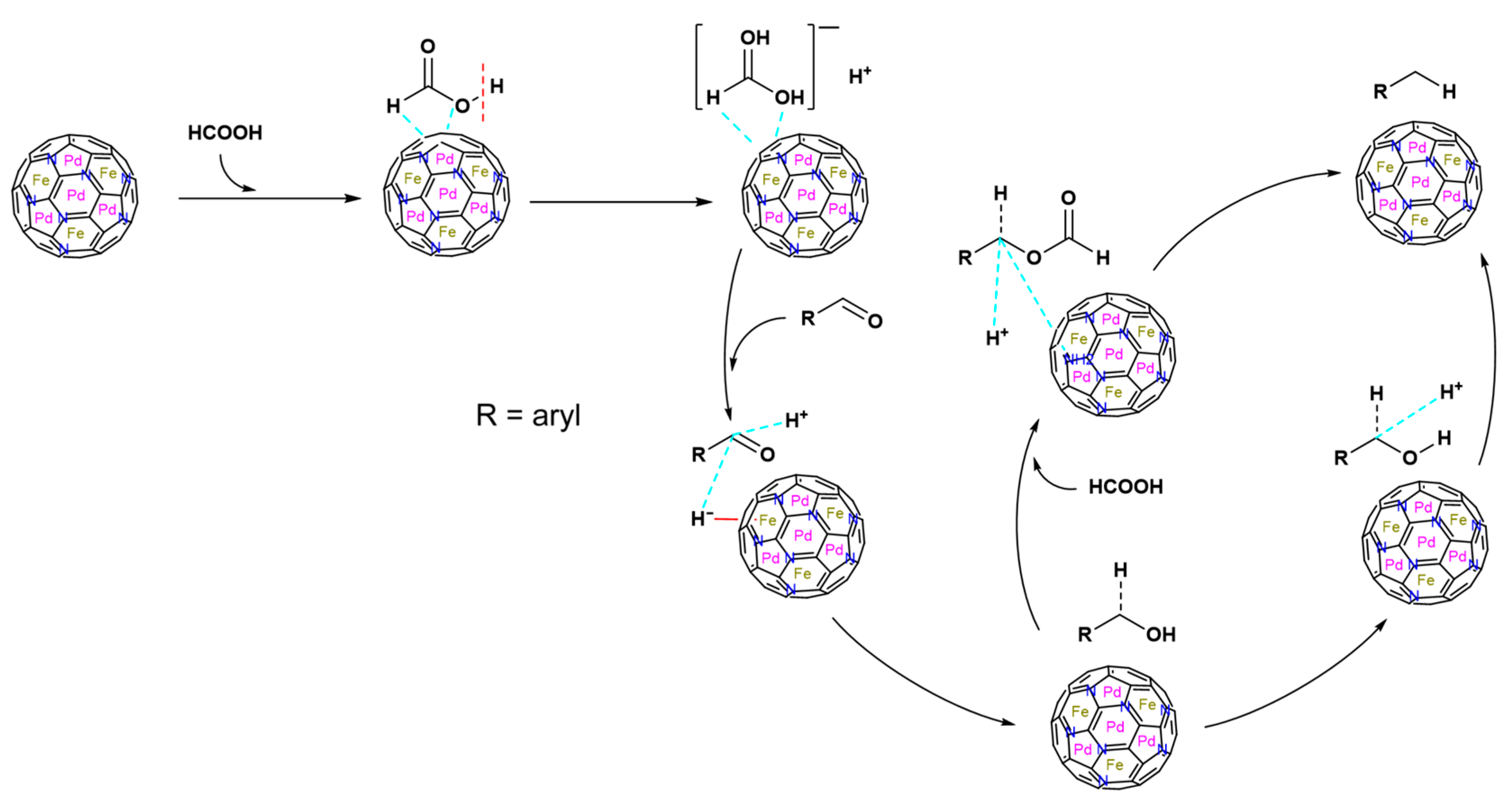
| Catalyst | Pd Content (wt.%) | Fe Content (wt.%) |
|---|---|---|
| Pd@N/C | 6.9 | undetectable |
| Fe@N/C | undetectable | 13.0 |
| Pd/Fe@N/C | 0.7 | 15.1 |
| Entry | Catalyst | Main Product | Reaction Conditions | Conv. (%) | Sel. (%) | Reference |
|---|---|---|---|---|---|---|
| 1 | Pd/C | VA | 30 °C, 7 bar H2, water, 90 min | >99 | >99 | Ref. [6] |
| 2 | Pd/Norit | MMP | 50 °C, 5 bar H2, isopropanol, 300 min | 100 | >99.5 | Ref. [8] |
| 3 | Pd/HHT | MMP | 50 °C, 5 bar H2, isopropanol, 240 min | 100 | >99.5 | Ref. [8] |
| 4 | Ni/ZrP | MMP | 220 °C, 5 bar H2, isopropanol, 30min | 97.25 | 90.89 | Ref. [9] |
| 5 | Cu/AC-600 | MMP | 120 °C, 20 bar H2, water, 300 min | 99.9 | 93.2 | Ref. [10] |
| 6 | Ni–Co–P/HAP (hydroxyapatite) | MMP | 200 °C, formic acid, isopropanol, 300 min | 97.86 | 93.97 | Ref. [7] |
| 7 | Cu/AC-600 | MMP | 180 °C, 2-propanol, 300 min | 99.8 | 99.1 | Ref. [10] |
| 8 | Pd/Fe@N/C | VA | 80 °C, formic acid, water, 60 min | 93.2 | 89.6 | This work |
| 9 | Pd/Fe@N/C | MMP | 80 °C, formic acid, cyclohexane, 300 min | 92.3 | 99.0 | This work |
| Entry a | Substrate | Product | Conv. b (%) | Sel. b (%) |
|---|---|---|---|---|
| 1 |  |  | 96.1 | 97.4 |
| 2 |  |  | >99 | 98.0 |
| 3 |  |  | 97.5 | 96.2 |
| 4 |  |  | 85.9 | 95.3 |
| 5 |  |  | >99 | 93.3 |
| 6 |  |  | 84.4 | 86.4 |
Disclaimer/Publisher’s Note: The statements, opinions and data contained in all publications are solely those of the individual author(s) and contributor(s) and not of MDPI and/or the editor(s). MDPI and/or the editor(s) disclaim responsibility for any injury to people or property resulting from any ideas, methods, instructions or products referred to in the content. |
© 2025 by the authors. Licensee MDPI, Basel, Switzerland. This article is an open access article distributed under the terms and conditions of the Creative Commons Attribution (CC BY) license (https://creativecommons.org/licenses/by/4.0/).
Share and Cite
Zuo, H.; Lei, Y.; Liu, J. Transfer Hydrogenation of Vanillin with Formic Acid over Graphene-Encapsulated Nitrogen-Doped Bimetallic Magnetic Pd/Fe@N/C Catalyst. Catalysts 2025, 15, 906. https://doi.org/10.3390/catal15090906
Zuo H, Lei Y, Liu J. Transfer Hydrogenation of Vanillin with Formic Acid over Graphene-Encapsulated Nitrogen-Doped Bimetallic Magnetic Pd/Fe@N/C Catalyst. Catalysts. 2025; 15(9):906. https://doi.org/10.3390/catal15090906
Chicago/Turabian StyleZuo, Hualiang, Yulong Lei, and Jianguo Liu. 2025. "Transfer Hydrogenation of Vanillin with Formic Acid over Graphene-Encapsulated Nitrogen-Doped Bimetallic Magnetic Pd/Fe@N/C Catalyst" Catalysts 15, no. 9: 906. https://doi.org/10.3390/catal15090906
APA StyleZuo, H., Lei, Y., & Liu, J. (2025). Transfer Hydrogenation of Vanillin with Formic Acid over Graphene-Encapsulated Nitrogen-Doped Bimetallic Magnetic Pd/Fe@N/C Catalyst. Catalysts, 15(9), 906. https://doi.org/10.3390/catal15090906







